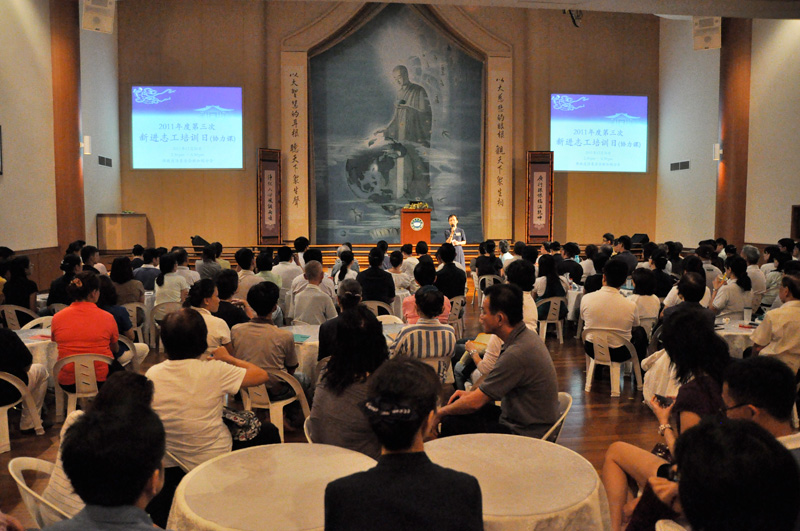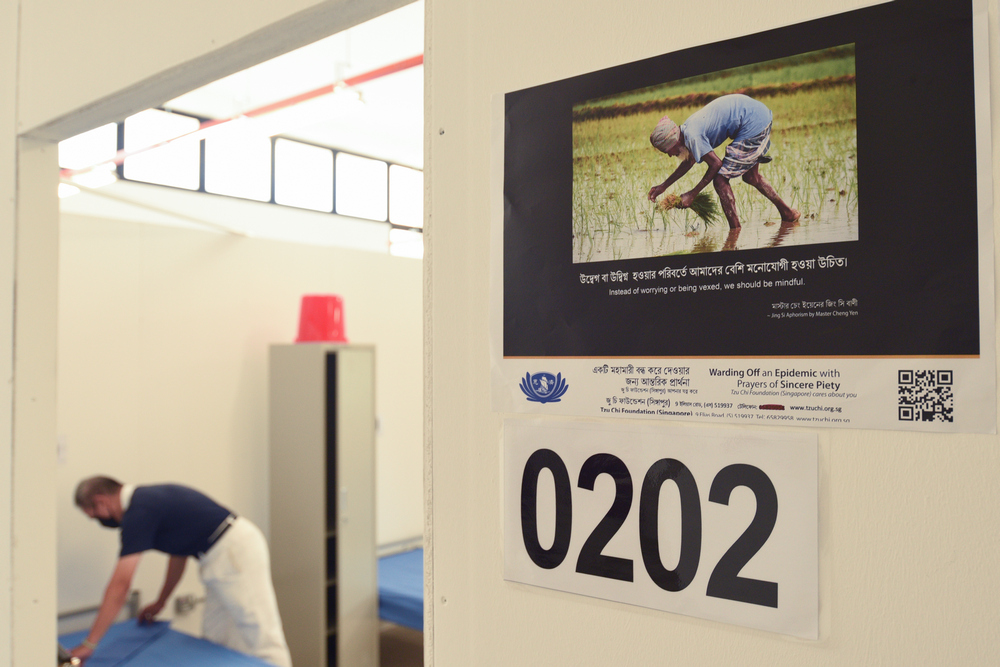
Members of the water/electricity sub-team seizing the weekend hours to install wires and lights at the base of the Buddha bathing altars. (Photo by Chong Ai Chung)
A standard rugby field, an 8-lane running track and two 9-tier grandstands with a seating capacity of 2000 is the usual venue for communal exercising and mostly, a soccer match. This was also the venue for this year’s Buddha Day Ceremony for Tzu Chi Singapore on 8 May.
Boasting multi-purpose spaces, the Yio Chu Kang Stadium in Ang Mo Kio is much bigger than the hall of Tzu Chi Singapore’s chapter that could only accommodate 500 people. However, this spacious venue also meant more challenges for the organizing and setup committee.
How is it possible to transform an outdoor stadium to a venue elegant enough to hold a religious ceremony? Apparently the setup/deco team led by volunteer couple Mok Peng San and Seow Beng Lan has what it takes.
Faced with a much bigger venue, the volunteer couple decided to divide the space into interior space and exterior space. The interior space would be the main Buddha bathing area taken up by the carpentry and water/electricity sub-teams while the exterior space would cover a booth displaying Tzu Chi’s Jing Si Publication, a corridor furnished with black-and-white pictures of Master Cheng Yen and historical pictures chronicling Tzu Chi’s humble beginnings (in line with its 45th anniversary this year), a Buddha Day exhibit and a dharma masters’ reception area transformed from a badminton court.
Planning the Buddha bathing area
The most important setting of the Buddha Day Ceremony was none other than the wooden Buddha bathing altars which took the team almost three months to brainstorm, design, and craft.
Knowing that Tzu Chi KL & Selangor branch had been conducting outdoor ceremonies for several years, the team travelled to Kuala Lumpur in November last year to learn about the setting up and layout design of the outdoor Buddha Day Ceremony.
After numerous meeting discussions with reference to the altar specification of the KL & Selangor branch, the team finally settled with a 5m by 1m round altar and two 17m long altars as the main setting of the Buddha bathing area.
The three handmade altars were expected to hold three huge Lapis Lazuli Buddha statues and 100 smaller ones. The round altar was crafted with a reservoir at the inner rim and the outer rim would be decorated with white, elegant flowers and water spray nozzles to create a misty and ethereal atmosphere during the Buddha bathing rituals.
Throughout the three months, the construction and assembly of the three Buddha bathing altars were carried out at the backyard of chapter house with team members coming in every weekend to saw wood, drill holes, install water and electrical fittings and etc.
In addition, volunteers had to segregate and label the massive amount of bolts, screws, and electrical wires of the altars to avoid mixing them up.
Regarding Tzu Chi’s work as own duty
Similar to building the Buddha bathing altar, the setup/deco team was also formed from scratch with immense effort put into gathering talents and manpower.
Tay Peck Moon from Shanghai was one of the three professional carpenters instrumental in the building of the Buddha bathing altars.
The crafted carpenter was nicknamed “Rock” by his wife Chua Hoe Lock because of his unsparing demands for perfection and unapproachable manner. Sister Chua’s previous “overzealous” involvement in Tzu Chi apparently stirred up some dissatisfaction from the husband who complained that she has not been fulfilling her duty as a homemaker.
Once, Tzu Chi entrepreneur volunteer Chang Cheng Chang invited Tay to help with designing and building a prefabricated house (a post-disaster construction project undertaken with Tzu Chi International Humanitarian Aid Association) to which he accepted and got to know a little more about Tzu Chi. When the setup/deco team heard of his craftsmanship, they quickly enlisted Tay to help build the Buddha bathing altars. Tay said in a later interview that he has never been so happy contributing.
Indeed, in just a short two months, everyone began seeing smiles on Tay’s stern face. The carpenter even recruited his two colleagues Tan Hai Koon and Tu Teng Ying to join the team.
This April, Tay signed up for the root-searching trip to Tzu Chi’s spiritual home in Hualien, eastern Taiwan. “I still remember a senior volunteer sharing this with us during the trip: ‘The reason God gave us wealth is not for us to keep them but to use them for the benefit of all. This is rather similar to what I heard from a Tzu Chi volunteer many years back. He said to me, ‘We’re like living in a pool. You pour out some water and they will flow back’.”
The serendipity led him to contemplate on his life perspective and he has since decided to regard Tzu Chi’s work as his own duty.
Speaking of the setup/deco team which comprised of both professionals and amateurs, Sister Seow said, “We can see the team members covering one another all the time. I’m most touched by the solidarity and understanding demonstrated by them.” There was tenderness in her eyes as with the other times when she spoke of her team.
“We did not place too much emphasis on the technical part but more on engaging the new members to experience Tzu Chi’s way of doing things and giving them a sense of purpose and belonging while endeavouring for a significant event that will form good affinity with the masses,” she added.
Leader of the water/electricity sub-team, Brother Loi Hui Thin was most grateful that Sister Seow sought out the possibility to set up a setup/deco team, making it a formal working team for the Singapore branch.
With unity and efforts from the setup/deco team, the simple stadium was successfully transformed into a sea of calm and tranquility on 8 May, presenting a scene akin to the Pure Land right in front of every volunteer and participant.
Our heartfelt gratitude to these unsung heroes behind the scene for their immense creativity and hard work throughout the past months.
Sister Seow Beng Lan (second from left), a graphic designer by profession, tirelessly engages the setup/deco team members in discussions and brainstorming. (Photo by Chan Wai Hoe)

Having installed the water and electricity fittings, the team conducts numerous trials to ensure the compatibility and safety of the fittings. (Photo by Chong Ai Chung)
Brother Tay Peck Moon has contributed much to the building of the Buddha bathing altar. (Photo by Chong Ai Chung)
Screwing work in progress. (Photo by Wong Twee Hee)
Team members inspecting the leakage problem of the round altar. (Photo by Wong Twee Hee)
Sister Ong Suan Heok, who works in a bridal shop, managed to enlist her employer and colleagues as well as supplier to help sew the silky covers for the altars. (Photo by Ng Ching Hang)
The floral team decorating the altars. Among them are florists leading amateur helpers. (Photo by Chua Teong Seng)
Brother Tay’s colleague, Tan Hai Koon (in grey uniform), busy at work. (Photo by Chua Teong Seng)
Brother Tay’s another colleague, Tu Teng Ying, laying the electrical wires on the stadium lawn with fellow volunteers. (Photo by Chua Teong Seng)
Team members decorating the stadium’s badminton court which will be transformed into the reception area for dharma masters. (Photo by Chai Yu Leong)
The round Buddha bathing altar was especially sanctifying under the beautiful sunset sky. (Photo by Wong Twee Hee)



